Part I: Many factors driving today's combined heat and power industry

By Joe Palenik
Editor's note: This article marks the first installment of a four-part series looking at the trends, issues, barriers and future of the combined heat and power (CHP) industry. The author of the series, Joe Palenik, is new to Power Online's cadre of regularly featured writers.
With a wealth of energy industry knowledge to share, Palenik starts the CHP series with an overview of the industry's history and current status and trends. Also, Palenik features the CHP Challenge issued by the U.S. Department of Energy and the Environmental Protection Agency and a Trigen CHP project in two smaller stories below the broad overview. Enjoy, and stay posted for Part II in October. ACM
Electricity shortages, deregulation, the environment, efficiency and good, old-fashioned dollars/cents considerations are driving the latest round of interest in combined heat and power (CHP), or producing usable thermal energy and at least another product, like horsepower or electricity.
"In the industrial arena,  it never went away," said Neal Elliott, a senior associate at the American Council for an Energy-Efficient Economy, a Washington, D.C., think tank. He's also past president of the United States Combined Heat and Power Association (USCHPA), which aims to make CHP the way to go (see sidebar, USCHPA takes on challenge).
it never went away," said Neal Elliott, a senior associate at the American Council for an Energy-Efficient Economy, a Washington, D.C., think tank. He's also past president of the United States Combined Heat and Power Association (USCHPA), which aims to make CHP the way to go (see sidebar, USCHPA takes on challenge).
Around the turn of the century, manufacturers produced their own electricity with on-site boilers that provided process steam and electrons for lighting and in some cases to electrify company-established towns.
Upstart entrepreneurs established electric utilities, which interconnected for reliability, and many manufacturers by the Roaring '20s were buying the product from someone else.
Attractive to energy-intensive industries
However, many energy-intensive industries like pulp/paper, chemical and petroleum have traditionally continued to self generate and add more capacity. Elliott said that about 10 GW of CHP was operating in this country around 1980, when the Public Utility Regulatory Policies Act (PURPA) required utilities to purchase electricity from independent producers that had to meet specific efficiency standards to maintain their qualifying facility status.
PURPA created a new generation of upstart entrepreneurs, some of whom were backed by traditional regulated utilities and some with considerably less financing but a lot of hustle. Finding thermal hosts wasn't hard.
Who wouldn't want an on-site or at least nearby source of thermal energy and electricity? Sometimes, the host became a partner and/or contributed a waste product that could be used as fuel, making the overall operation more efficient.
Energy Policy Act
By 1992, when the Energy Policy Act created a new class of generating company that didn't have to meet efficiency standards, CHP provided about 40 GW of power domestically.
In today's climate, CHP provides about 9% of the country's electricity.
In addition to regulatory stimulus, CHP has several other pilings supporting it, like engine technology, computer-controlled operation and efficiency goals driven by environmental considerations.
Efficiency and the environment
Efficiency equals environmental benefits (see sidebar, CHP gives steam loop new life).
According to Skip Laitner, a senior economist for the U.S. Environmental Protection Agency's Office of Atmospheric Programs, "You have one fire doing both electrical and mechanical or thermal load instead of one fire in a building to produce heat or cooling and another fire in an electric plant producing electricity. As a result, you've got much lower emissions of NOx in particular, but also greenhouse gases and sulfur emissions."
Elliott credits highly efficient combustion turbines that descended from jet aircraft engines as the most important piece of CHP technology to come along. "The new generation of CTs," he said, "is more efficient and reliable and cheaper than they were when I got into this business 25 years ago."
The sizes have dropped while efficiency has increased, he said. Available sizes vary from around 500 kW and up, providing a size for just about any application.
It's not only the gas turbines that have improved.
What's been the standard workhorse for small-scale CHP, the diesel engine, has come a long way, with engine efficiencies exceeding 40% and using clean-burning natural gas instead of fuel oil. With state-of-the art controls, they squeeze the last Btu from fuel.
Coupled with heat recovery from the exhaust, cooling jacket and engine oil and hooked up to a generator, efficiency increases because the unit is doing much more work.
New technologies
New technologies include microturbines and fuel cells.
Microturbines, adaptable to CHP, are available in sizes less than 100 kW, large enough, for example, to power a convenience store or a fast-food operation. Fuel cells are a natural for CHP because they produce heat. "For a fuel cell to be efficient, you have to operate it as a cogeneration system," Elliott said.
Dwindling reserve margins and the need for reliable industrial power are major CHP drivers, and industry deregulation gives CHP proponents a better foot in the door. According to Elliott, some areas are lucky to have a 10% reserve margin.
"Probably half of the United States is well below the 10% reserve level," he said. That means the loss of one large plant in a power pool could create chaos if import capacity is not available.
Computers demand quality power
In addition, there is a demand for high-quality and reliable power among companies that rely heavily on computers, which require spike-free, steady power for smooth operation.
CHP's future looks bright, according to both Elliott and Richard Brent, director of government affairs for Solar Turbines and a member of USCHPA's steering committee.
"There are a number of advantages," Brent said. "It's the most efficient production of useful energy, heat and electricity. It has the greatest opportunity through high efficiency to reduce carbon consumption. The combination of reducing carbon consumption and pollution prevention technology makes it an environmentally preferred energy system."
He added, "The way the business of the regulated monopolies was structured did not allow for competing energy products to be delivered to end users. The regulated utility structure through interconnection and rates had in its design the ability to strand combined heat and power system opportunities. We aim to change that."
It's a new ball game
Utilities no longer have the market on generation cornered, and many of the "upstart" companies that operated qualifying facilities under PURPA now rule the roost.
For example, the Independent Power Producers of New York now represents 64% of  the state's capacity. "We went from being David to Goliath," said Carol E. Murphy, executive director.
the state's capacity. "We went from being David to Goliath," said Carol E. Murphy, executive director.
Not all IPPNY members are involved in CHP. These days, a site where transmission capacity is available is a major find.
New York needs to do two things to get the ball rolling, she said. One is getting the power interchange to work smoothly, and the other is to get more generation sited.
"You just don't switch from 100 years of monopoly service...and expect everything's going to work perfectly," she said.
About the author: Palenik, 53, grew up in the coalfields of western Pennsylvania, where the economy at one time was tied heavily to coal and steel. He's been writing more than 25 years, about 15 of which covered energy and energy-related issues. He's freelanced for a variety of print and electronic publications, including about 10 years with a group of McGraw-Hill energy and business publications. lavender@dmv.com.
USCHPA takes on challenge
The gauntlet has been dropped, and the United States Combined Heat and Power Association (USCHPA) has accepted a federal challenge to double the amount of industrial combined heat and power (CHP) operating domestically by 2010.
The challenge was delivered by the U.S. Department of Energy (DOE) and the Environmental Protection Agency (EPA), which each have their specific reasons for encouraging CHP. The DOE's hook is more efficient businesses, and the EPA's hook is a cleaner environment. USCHPA's target is at least 46 new GW, matching the amount the DOE counted in 1996.
From USCHPA's Combined Heat and Power: A Vision for the Future of CHP in the U.S. in 2020, the following three charts provide a graphic picture of both the impetus for this challenge and the market's potential.
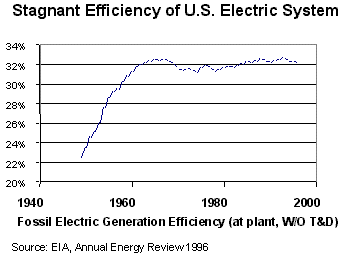
According to USCHPA's vision for the future, "On average, two-thirds of the fuel used to make electricity in the United States is wasted. While there have been impressive energy efficiency gains in other sectors of the economy since the oil price shocks of the 1970s, the average efficiency of power generation in the United States has remained around 33% since 1960."
In contrast, CHP systems operate at around 70% or better, USCHPA notes.
The task is to get the word around that CHP is a good investment and demolish some of the barriers that have traditionally hampered CHP. Those problems include utility resistance, different treatments by different state environmental and regulatory agencies and federal tax regulations.
The word may already be out
But the word already may be out on the street, according to Skip Laitner, a senior economist for the federal EPA's Office of Atmospheric Programs. "We're saying it looks like combined heat and power technologies are going to penetrate faster than what's understood."
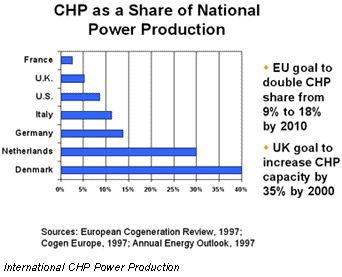
The 46 GW of CHP the group started with apparently is less than what's really out there, Laitner said. The DOE's latest Annual Energy Outlook indicates that there will be maybe 70 GW or 75 GW of CHP operating by 2010, including a normal growth of about 11 GW during the decade, which leaves USCHPA still responsible for stimulating about 25 GW.
Industry flux equals foot in the door
With deregulation, the industry is in a flux and provides opportunities to crash some long-standing barriers, said Neal Elliott, a former USCHPA president and a senior associate at the American Council for an Energy-Efficient Economy.
"I think we're at a nexus," he said. "All the stars are aligned for creating a market that would be receptive for widespread deployment of CHP."
Interconnection, for example, is a hodgepodge of state laws that were crafted as situations evolved.
"Right now," Elliott said, "a lot of electric utilities and a lot of the electric regulators out there don't make that easy. They make it difficult, and difficult translates into dollars and time. So we need some standard rules."
Environmental permitting hodgepodge
Ditto for environmental permitting. State rules, while similar to the federal EPA's, have nuances that frustrate progress.
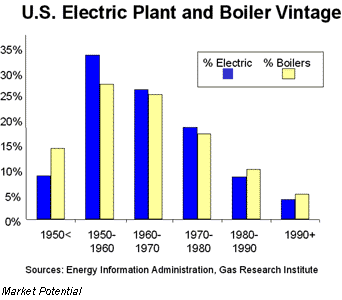
"We see our role to establish with confidence that the technologies are indeed environmentally friendly and to show that the market is able to make the right kinds of investments that maintain both the cost savings and the environmental benefits," Laitner said. "If we provide a consistent methodology or consistent way to evaluate this technology so it is presumed to be environmentally friendly, it really accelerates the permitting process from state to state."
Tax treatments tax common sense
Then there is the tax treatment.
Elliott said he can depreciate a combustion turbine over five years if it's mobile on a flatbed trailer, over 10 years if he bolts it to a pad, over 15 years if he generates electricity for his own use, over 20 years if he sells electricity to a customer, over 27 ½ years if he puts it into a building he rents out and over 39 years if he owns and occupies the building.
USCHPA is pushing a seven-year writeoff. "That makes sense," Elliott said. "That represents the economic life of that product."
By Joe Palenik (Back to main story)
CHP gives steam loop new life
Trigen Energy of White Plains, NY, which is heavily committed to CHP and its environmental benefits, has given new life to its Philadelphia district heating loop with a combined cycle plant that both supplies the 33-mile system with steam and produces 150 MW of electricity sold under contract.
Trigen owns and operates several other district systems and purchased the Philadelphia system in 1987 from what was then Philadelphia Electric. Immediately, Trigen began catching up with deferred maintenance on the loop, which was built in the 1930s and 40s and suffered from neglect.
"Early on, we did a lot of capital investment into the existing facilities," said Herman Schopman, president of the steam loop and Grays Ferry Cogeneration Partnership, which owns and operates the 170 MW CHP system that supplies the loop with up to 600 lb/hr of thermal energy. Calipne is an equal partner in the CHP plant.
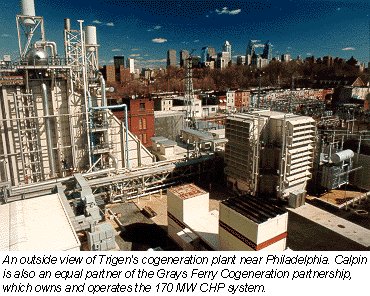
CHP replaces aged boiler
The CHP system started operating in January 1998 and is a separate company from the steam loop, which is regulated by the Pennsylvania Public Utility Commission. The new hardware replaces an aged 50-MW turbine that's been mothballed.
The CHP unit's thermal output is routed to the 400-customer steam loop, which peaks at around 1.5 million lb/hr of steam. The additional 900 lb/hr of thermal energy for the loop is provided by a Cerrey high-pressure boiler.
The facility sells electricity to PECO Energy under a 20-year contract specifying a fixed rate for the first three years. Rates for the last 17 years will float with the marketplace.
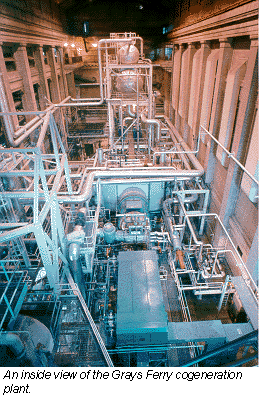
Grays Ferry remains a qualifying facility under the Public Utility Regulatory Policies Act and must meet efficiency standards to maintain both its QF status and its contract with PECO, which also dispatches the unit for the Pennsylvania-New Jersey-Maryland Interconnection. The must-run facility operates at over 90% availability and at an efficiency of 75%, Trigen said.
Contracts indexed to fuel, transportation costs
The primary fuel is natural gas supplied by Aquila Energy with No. 2 fuel oil as a backup. The gas contracts are indexed for both commodity and transportation changes, and the 25-year contract for thermal energy to the steam loop is indexed to fuel costs. A few pressure problems that surfaced last winter are being worked out with Texas Eastern Transmission, which transports the fuel.
As is typical, there were some shakedown issues.
"Shakedown and startup problems are not atypical for any plant," said Schopman. "I don't think that we've had anything serious. We've had some problems, but we've gotten through them."
The major equipment includes a Westinghouse combustion turbine, a Mitsubishi steam turbine and a Nooter/Eriksen heat recovery steam generator.
By Joe Palenik (Back to main story)
